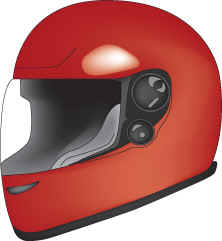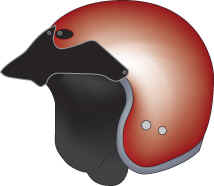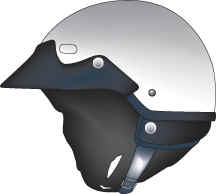| Wear the proper gear
| ||
| In Alberta, operators and passengers of motorcycles, mopes or power bicycles must wear an approved safety helmet that is securely attached to the person?s head.
| ||
| Full coverage (full face) |
| |
Three-quarter coverage (open face) | ||
|
|
| |
One-half coverage (shorty) | ||
| |
| |
When choosing a helmet, wear it for five to ten minutes. This will let you know if the helmet will become uncomfortable before buying it.
Also, be sure it fits properly all the way around. Fasten it securely on your head when you ride. If it is possible to remove the helmet without loosening the chin strap then the helmet is not safe.
An approved helmet will have a sticker to show that it meets current safety standards. According to the Vehicle Equipment Regulation 322/2002, section 93:
(1) A safety helmet intended for the use of an operator or a passenger of a cycle must meet one or more of the standards for motorcycle safety helmets adopted under subsection (3) in effect on the date on which it was manufactured.
(2) The following are adopted and apply to safety helmets in accordance with subsection (1):
(a) CSA Standard CAN3-D230-M85
(b) U.S.A. Federal Motor Vehicle Safety Standard FMVSS 218 Motorcycle Helmets 1993 OCT
(c) U.S.A. Federal Motor Vehicle Safety Standards FMVSS 218 Motorcycle Helmets 2000 OCT
(d) British Standards Institute Standard BSI-B6658 ? 1995 (e) Snell Memorial Foundation.
(3) A safety helmet must have the mark or label CSA, DOT or BSI or the mark or label of the organization in subsection (2)(e) indicating that the safety helmet met one or more of the specifications required on the date on which it was manufactured.
(4) No person shall buy, sell or offer for sale a safety helmet intended for the use of operators or passengers of cycles unless it complies with subsections (1) to (3).
A plastic shatter-resistant face shield will help protect your face from wind, dust, dirt, rain, insects and rocks thrown up from other vehicles. These problems are distracting, painful and dangerous. If you have to deal with the distractions, you may not be able to give your full attention to the road. Eyeglasses or sunglasses may not provide adequate protection for your eyes. There are a number of motorcycle eyewear products suitable for riding that provide additional protection.
Most motorcycle windshields do not give adequate protection for your eyes or face. The best protection is a full-face helmet with a built-in face shield.
If you choose a helmet that does not have full-face protection, you should consider eyewear that is specifically designed for motorcycle riding to protect your eyes. If you wear corrective glasses, you should wear goggles that go over the glasses for protection.
To be effective, eye or face shield protection must:
- be free of scratches
- be resistant to penetration
- give a clear view to either side
- fasten securely so it does not blow off
- permit enough room for eyeglasses or sunglasses if needed.
Tinted eye protection should not be worn at night or any other time when the light conditions are poor. If tinted eye protection is used, remember to carry a clear shield for reduced visibility.
| |||
| Clothing designed for motorcycle riders provides the best protection from scraps and cuts during a collision. It also protects from weather and debris. Clothing should be worn in layers so that a rider can adjust to the changing weather conditions. Jackets and pants Jackets and pants should cover your arms and legs completely. They should be snug enough to not flap in the wind, yet loose enough to move freely and cover your layered clothing. Sturdy synthetic textiles or motorcycle thickness leather provides the best protection. Jeans give only minimum protection and will wear through quickly when skidding on the road surface in the event of a collision at highway speeds. Riding in lightweight pants, shorts or lightweight nylon material is not recommended.
| |||
| Choose bright coloured clothing that will help you to be visible when riding. Reflective strips on your motorcycle, helmet and jacket will make you more visible at night. In cold or wet weather, proper clothing should help keep you warm and dry. A cold weather jacket designed for motorcycle riding should resist wind and fit snugly at the neck and wrists. A good quality motorcycle rain suit will not balloon or tear apart at highway speeds. It should have long sleeves, legs and extra room to fit comfortably over your regular riding clothes.
|
| ||
Hypothermia
Hypothermia occurs when the body loses internal heat due to cold or wind chill conditions. Motorcyclists are especially at risk for rapid chilling, which will lead to a slowing of reflexes and response time. Hypothermia can also reduce a rider?s ability to concentrate and react to changing traffic conditions. Even in warm weather, the constant exposure to wind when riding may cause hypothermia. Proper riding gear such as a windproof jacket and insulated layers of clothing are essential.
Hyperthermia, dehydration and hot weather
Hyperthermia is when the body temperature rises markedly. It can occur with overexposure to high temperatures in the environment. To avoid overheating, a rider should stay well hydrated by drinking plenty of water prior to and during the ride when taking breaks. Modern motorcycle specific riding coats and helmets may come with venting, which will allow for some airflow. Riding without a coat will only make the effects of hyperthermia worse. Plan for frequent water breaks and rest periods that are directly out of the sunlight where possible.
In very hot weather, hot wind passing over exposed skin will quickly dry the moisture out of your body causing dehydration. Wearing a proper jacket will reduce the chances of becoming dehydrated.
Boots or shoes
Your boots or shoes should cover your ankles and be made of leather or other synthetic material. The soles should be made of durable slip resistant material that will provide enough grip to keep your feet from slipping and you from losing control of the motorcycle. Proper footwear should also allow you to operate the foot controls effectively. Keep the heels short so they do not catch on rough surfaces or the controls. Tuck the laces in so that they do not catch on the motorcycle.
Wear gloves that allow you to grip the controls and protect your hands in a crash. It is best to use gloves that are designed for motorcycle riding. The gloves should be made of leather or similar durable material, be comfortable, and flexible. They should cover your wrists and overlap the sleeves of the jacket. Cold weather and water resistant gloves are also available for cooler weather. | |||
Unlike the driver of a car, you have no seat belt or metal around you for protection in a collision. Always drive with extreme care. You cannot be sure that other drivers will see you or that they will yield the right-of-way to you when required. A large number of motorcycle collisions happen to riders with just a few months of operating experience. You should get the experience necessary under the best conditions and in light traffic. To reduce the risk of being in a collision, do the following.
| |||
Cell phones are convenient but can divert attention away from the riding task. Pull over to the side of the road when using a cell phone, including a hand-free phone. A good practice is to check for messages each time you take a break from riding.








.jpg)
1 comment:
There are many different types of motorcycle helmets to choose from at one of several helmet stores in phoenix. I went into a phoenix helmet store and found some cool dirt bike helmets, full face helmets that cover down to your mouth, half helmets and a wide selection of shields to accompany the motorcycle helmet. DOT certification is required for helmets.
When selecting a helmet, be sure that you know what size to get. You do not want a motorcycle helmet fits your head like a shoe! Check out the size charts for each helmet. Feel free to contact us about custom orders. You can get a helmet from helmet store phoenix that matches the colors of your bike.
Post a Comment